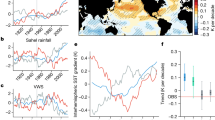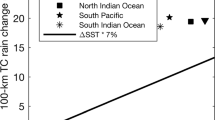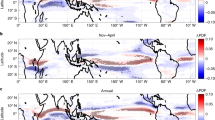Abstract
Assessing potential changes in North Atlantic (NA) tropical storm (TS) activity this century is of paramount societal and economic significance, and the topic of intense scientific research1. We explore projections of NA TS changes over the twenty-first century by applying a statistical downscaling methodology2,3 to a suite of experiments with the latest state-of-the-art global coupled climate models4. We also apply a methodology5 to partition the dominant sources of uncertainty in the TS projections. We find that over the first half of the twenty-first century radiative forcing changes act to increase NA TS frequency; this increase arises from radiative forcings other than increasing CO2 (probably aerosols). However, NA TS trends over the entire twenty-first century are of ambiguous sign. We find that for NA TS frequency, in contrast to sea surface temperature (SST), the largest uncertainties are driven by the chaotic nature of the climate system and by the climate response to radiative forcing. These results highlight the need to better understand the processes controlling patterns of SST change in response to radiative forcing and internal climate variability to constrain estimates of future NA TS activity. Coordinated experiments isolating forcing agents in projections should improve our understanding, and would enable better assessment of future TS activity.
This is a preview of subscription content, access via your institution
Access options
Subscribe to this journal
Receive 12 print issues and online access
$209.00 per year
only $17.42 per issue
Buy this article
- Purchase on Springer Link
- Instant access to full article PDF
Prices may be subject to local taxes which are calculated during checkout




Similar content being viewed by others
References
Knutson, T. R. et al. Tropical cyclones and climate change. Nature Geosci. 3, 157–163 (2010).
Villarini, G., Vecchi, G. A. & Smith, J. A. Modeling of the dependence of tropical storm counts in the North Atlantic Basin on climate indices. Mon. Weath. Rev. 138, 2681–2705 (2010).
Villarini, G., Vecchi, G. A., Knutson, T. R., Zhao, M. & Smith, J. A. North Atlantic tropical storm frequency response to anthropogenic forcing: Projections and sources of uncertainty. J. Clim. 24, 3224–3238 (2011).
Taylor, K. E., Stouffer, R. J. & Meehl, G. A. An overview of CMIP5 and the experiment design. Bull. Am. Meteorol. Soc. 93, 485–498 (2012).
Hawkins, E. & Sutton, R. The potential to narrow uncertainty in regional climate predictions. Bull. Am. Meteorol. Soc. 90, 1095–1107 (2009).
Sobel, A. H., Held, I. M. & Bretherton, C. S. The ENSO signal in tropical tropospheric temperature. J. Clim. 15, 2702–2706 (2002).
Emanuel, K. Increasing destructiveness of tropical cyclones over the past 30 years. Nature 436, 686–688 (2005).
Latif, M., Keenlyside, N. & Bader, J. Tropical sea surface temperature, vertical wind shear, and hurricane development. Geophys. Res. Lett. 34, L01710 (2007).
Vecchi, G. A. & Soden, B. J. Effect of remote sea surface temperature change on tropical cyclone potential intensity. Nature 450, 1066–1071 (2007).
Ramsay, H. A. & Sobel, A. H. Effects of relative and absolute sea surface temperature on tropical cyclone potential intensity using a single-column model. J. Clim. 24, 183–193 (2011).
Vecchi, G. A., Swanson, K. L. & Soden, B. J. Whither hurricane activity? Science 322, 687–689 (2008).
Donner, L. J. et al. The dynamical core, physical parameterizations, and basic simulation characteristics of the atmospheric component AM3 of the GFDL Global Coupled Model CM3. J. Clim. 24, 3484–3519 (2011).
Mann, M. E. & Emanuel, K. A. Atlantic hurricane trends linked to climate change. Eos Trans. Am. Geophys. Union 87, 233 (2006).
Zhang, R. & Delworth, T. L. Impact of Atlantic multidecadal oscillations on India/Sahel rainfall and Atlantic hurricanes. Geophys. Res. Lett. 33, L17712 (2006).
Zhang, R. & Delworth, T. L. A new method for attributing climate variations over the Atlantic Hurricane Basin’s main development region. Geophys. Res. Lett. 36, L06701 (2009).
Oouchi, K. et al. Tropical cyclone climatology in a global warming climate as simulated in a 20-km-mesh global atmospheric model: Frequency and wind intensity analysis. J. Meteorol. Soc. Jpn 84, 259–276 (2006).
Bender, M. A. et al. Model impact of anthropogenic warming on the frequency of intense Atlantic hurricanes. Science 327, 454–458 (2010).
Bengtsson, L. et al. How may tropical cyclones change in a warmer climate? Tellus 59A, 539–561 (2007).
Gualdi, S., Scoccimarro, E. & Navarra, A. Changes in tropical cyclone activity due to global warming: Results from a high-resolution coupled general circulation model. J. Clim. 21, 5204–5228 (2008).
Emanuel, K., Sundararajan, R. & Williams, J. Hurricanes and global warming—results from downscaling IPCC AR4 simulations. Bull. Am. Meteorol. Soc. 89, 347–367 (2008).
Knutson, T. R., Sirutis, J. J., Garner, S. T., Vecchi, G. A. & Held, I. Simulated reduction in Atlantic hurricane frequency under twenty-first-century warming conditions. Nature Geosci. 1, 359–364 (2008).
Sugi, M., Murakami, H. & Yoshimura, J. A reduction in global tropical cyclone frequency due to global warming. SOLA 5, 164–167 (2009).
Zhao, M., Held, I. M., Lin, S. J. & Vecchi, G. A. Simulations of global hurricane climatology, interannual variability, and response to global warming using a 50-km-resolution GCM. J. Clim. 22, 6653–6678 (2009).
Villarini, G. & Vecchi, G. A. North Atlantic Power Dissipation Index (PDI) and Accumulated Cyclone Energy (ACE): Statistical modeling and sensitivity to sea surface temperature changes. J. Clim. 25, 625–637 (2012).
Emanuel, K. Tropical cyclone activity downscaled from NOAA-CIRES Reanalysis, 1908–1958. J. Adv. Model. Earth Syst. 2, 1–12 (2010).
Hawkins, E. & Sutton, R. The potential to narrow uncertainty in projections of regional precipitation change. Clim. Dynam. 37, 407–418 (2011).
Xie, S-P. et al. Global warming pattern formation: Sea surface temperature and rainfall. J. Clim. 23, 966–986 (2010).
Smith, T. M., Reynolds, R. W., Peterson, T. C. & Lawrimore, J. Improvements to NOAA’s historical merged land–ocean surface temperature analysis (1880–2006). J. Clim. 21, 2283–2296 (2008).
McAdie, C., Landsea, C., Neumann, C. J., David, J. E. & Blake, E. S. Tropical Cyclones of the North Atlantic Ocean, 1851–2006 (with 2007 and 2008 track maps included.) (Natl Clim. Data Cent., 2009).
Landsea, C. W., Vecchi, G. A., Bengtsson, L. & Knutson, T. R. Impact of duration thresholds on Atlantic tropical cyclone counts. J. Clim. 23, 2508–2519 (2010).
Acknowledgements
We are grateful for comments from K. Dixon, I. Held, A. Johansson and R. Msadek. We also acknowledge useful comments by K. Emanuel. We are grateful to L. Donner and L. Horowitz for making perturbation experiments with GFDL-CM3 available to us. This work was partly supported by the Willis Research Network. We acknowledge the World Climate Research Programme’s Working Group on Coupled Modelling, which is responsible for CMIP, and we thank the climate modelling groups (listed in Supplementary Table S1) for producing and making available their model output. For CMIP the US Department of Energy’s Program for Climate Model Diagnosis and Intercomparison provides coordinating support and led development of software infrastructure in partnership with the Global Organization for Earth System Science Portals.
Author information
Authors and Affiliations
Contributions
Both authors contributed extensively to the work presented in this paper and to the writing.
Corresponding author
Ethics declarations
Competing interests
The authors declare no competing financial interests. However, in the interest of transparency, we confirm that Gabriele Villarini was funded through the Willis Research Network, which is part of the Willis Group. The results of this work were not influenced by possible financial gains or losses by the Willis Group.
Supplementary information
Rights and permissions
About this article
Cite this article
Villarini, G., Vecchi, G. Twenty-first-century projections of North Atlantic tropical storms from CMIP5 models. Nature Clim Change 2, 604–607 (2012). https://doi.org/10.1038/nclimate1530
Received:
Accepted:
Published:
Issue Date:
DOI: https://doi.org/10.1038/nclimate1530
This article is cited by
-
Last millennium hurricane activity linked to endogenous climate variability
Nature Communications (2024)
-
Poleward intensification of midlatitude extreme winds under warmer climate
npj Climate and Atmospheric Science (2023)
-
Recent rainfall variability over Rajasthan, India
Theoretical and Applied Climatology (2022)
-
Assessing the performance of 33 CMIP6 models in simulating the large-scale environmental fields of tropical cyclones
Climate Dynamics (2022)
-
Changes in Atlantic major hurricane frequency since the late-19th century
Nature Communications (2021)



